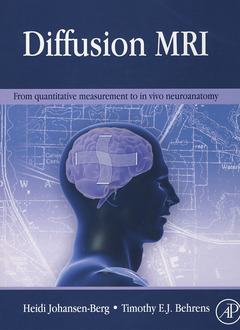Description
Diffusion MRI: from quantitative measurement to in-vivo neuroanatomy
Authors: JOHANSEN-BERG Heidi, BEHRENS Timothy E.J.
Language: English
Subjects for Diffusion MRI: from quantitative measurement to in-vivo...:
Approximative price 155.28 €
Subject to availability at the publisher.
Add to cart490 p. · 22x28 cm · Hardback
Description
/li>Contents
/li>Readership
/li>Comment
/li>
Introduction Peter Basser, NIH, USA
Pulse sequences for diffusion MRI Jim Pipe, University of Michigan, USA
Simple modeling the diffusion signal Derek Jones, Cardiff, UK
Complex modeling of the diffusion signal Danny Alexander, London, UK
Section 2: Diffusion MRI for quantitative measurement
Histological techniques for quantitative measurement of white matter microstructure TBA
The biological basis of the diffusion signal Christian Beaulieu, University of Alberta, Canada
Measuring anatomically meaningful parameters from diffusion MRI Yaniv Assaf, University of Tel Aviv, Israel
Local measurement of diffusion MRI parameters Steven Smith, University of Oxford, UK
Diffusion MRI and histological measurement in MS TBA
White matter changes throughout the lifespan: development and ageing David Salat, Harvard, USA
Structure-function relationships in the healthy brain Heidi Johansen-Berg, Oxford, UK
White matter measurement in neuropsychiatry TBA
Section 3: Diffusion MRI for in-vivo neuroanatomy
Classical techniques for tract tracing Bob Morecraft, University of South Dakota, USA and Deepak Pandya, Boston, USA
Introduction to diffusion MRI tractography Susumu Mori, Johns Hopkins University, USA
Probabilistic approaches to diffusion tractography Tim Behrens and Saad Jbabdi University of Oxford, UK
Validation of tractography Geoff Parker, Manchester, UK
Connectivity fingerprinting of the cortex Tim Behrens and Heidi Johansen-Berg, Oxford, UK
Language pathways in the human brain Marco Catani, Institute of Psychiatry, London, UK
Tractography for surgical targeting Andreas Bartsch, University of Wurzburg, Germany
Inter-species comparison of white matter anatomy using diffusion tractography Matthew Rushworth, Oxford, UK
Further reading material for Masters Courses in Neuroscience, Medical Physics which include a course in Brain Imaging, as well as Dedicated Masters courses in Brain Imaging (e.g., Rutgers, USA, UCLA, USA, Birmingham, UK)
"A thorough and exciting review of the diffusion MRI techniques that are going to rewrite our knowledge of the long tract anatomy of the human brain. Extremely well written and illustrated." - Michael S. Gazzaniga, Director, Sage Center for the Study of Mind, University of California, Santa Barbara, USA
"25 years after its debut, diffusion MRI today provides us with beautiful, marvelous images of connecting wires within the human brain, and this is achieved just by placing healthy subjects or patients in the middle of a strong magnet. How is this miracle possible? What could we expect from the knowledge of the brain connectome? This beautifully illustrated book addresses these questions with great clarity. The book is highly recommendable to all those who are interested in the links between brain structure and function." - Denis Le Bihan, Member of the Institut de France, Academy of Sciences, Director, NeuroSpin, CEA-Saclay Center, Gif-sur-Yvette, France
"Unbelievable as it may seem, we know almost nothing about the real connectivity of the human cerebral cortex. What we think we know is mostly inferred from results obtained in the monkey. This book provides an exciting exploration of diffusion tensor imaging, a method that can start to close this gap. The editors, who are themselves pioneers in this field, have assembled authoritative chapters on the promises that lie ahead and the challenges that will be encountered." - Marsel Mesulam, Ruth and Evelyn Dunbar Professor of Neurology, Psychiatry and Psychology, Director, The Cognitive Neurology and Alzheimer's Disease Center (CNADC), Feinberg School of Medicine, Northwestern University, Chicago, USA
"Diffusion MRI has tremendous potential for elucidating brain structure and circuitry in health and disease, but the approach is fraught with methodological and interpretational challenges. This excellent and authoritative book edited by Johansen-Berg and Behrens is an invaluab




